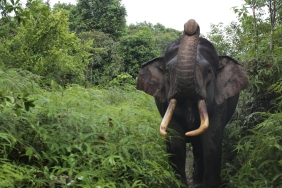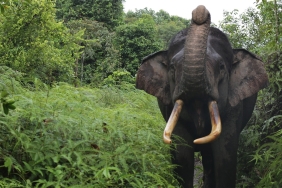LORENG, LIKE "KTP" FOR SUMATRAN TIGER
By: Nur Arinta
Ever wondered how researchers ensure that the Sumatran tigers they observe are distinct individuals?
Loreng is like a tiger's ID card. It is what distinguishes a tiger from other big cats such as tigers, lions or jaguars. Sumatran tigers have denser stripes than any other tiger subspecies in the world. Although it looks the same at first glance, the actual stripes of each individual tiger are different. That is why, for tigers, the stripes are like an identity for each individual, just like fingerprints on humans. Uniquely, these stripes are not only found on the tiger's hair, but are also attached to its skin. If the tiger's hair is shaved, then we can see the stripes that are also found on its skin and are exactly the same as the stripes found on its hair. The stripes on the tiger's body are not symmetrical, meaning that the pattern of the stripes on the tiger's body on its right and left sides are not the same. So you can imagine, if the researcher gets a photo of only one side, that's why the camera trap must be installed on two sides so as not to recognize it wrong.
The identifying part of the stripe is the stripe on the face and back of the tiger. The facial stripe is a diagnostic feature and needs to be considered when identifying individual Sumatran Tigers. The stripes on the tiger's back, where the stripes on the left and right sides of the body meet, also provide clues for researchers to recognize individual tigers.
In addition to the stripes on the body, face and back, the stripes on the legs and tail also help the identification process. Horizontal or vertical half-ring-shaped stripes found on tiger legs can add certainty to identifications that have been made from other parts. Meanwhile, the smudge on the tail that looks like a ring is also a concern of researchers when making identification.
This identification helps researchers confirm the population size of Sumatran Tigers in the remaining Sumatran forests. So, are you interested in becoming a Sumatran tiger researcher and supporting efforts to conserve Sumatran tigers in their habitat?
To support Sumatran tiger conservation efforts in their habitat, you don't need to become a tiger researcher and go directly to the forest! Simply by not consuming products that use tiger parts, reporting all forms of illegal Sumatran Tiger trade crimes, and reporting if you see Sumatran Tiger poaching. Don't forget to always save paper usage by doing double-sided printing, save tissue usage by doing 30 claps every time you wash your hands, and use certified forest products. Let's continue to support the conservation efforts of Indonesia's proud Sumatran Tiger!





